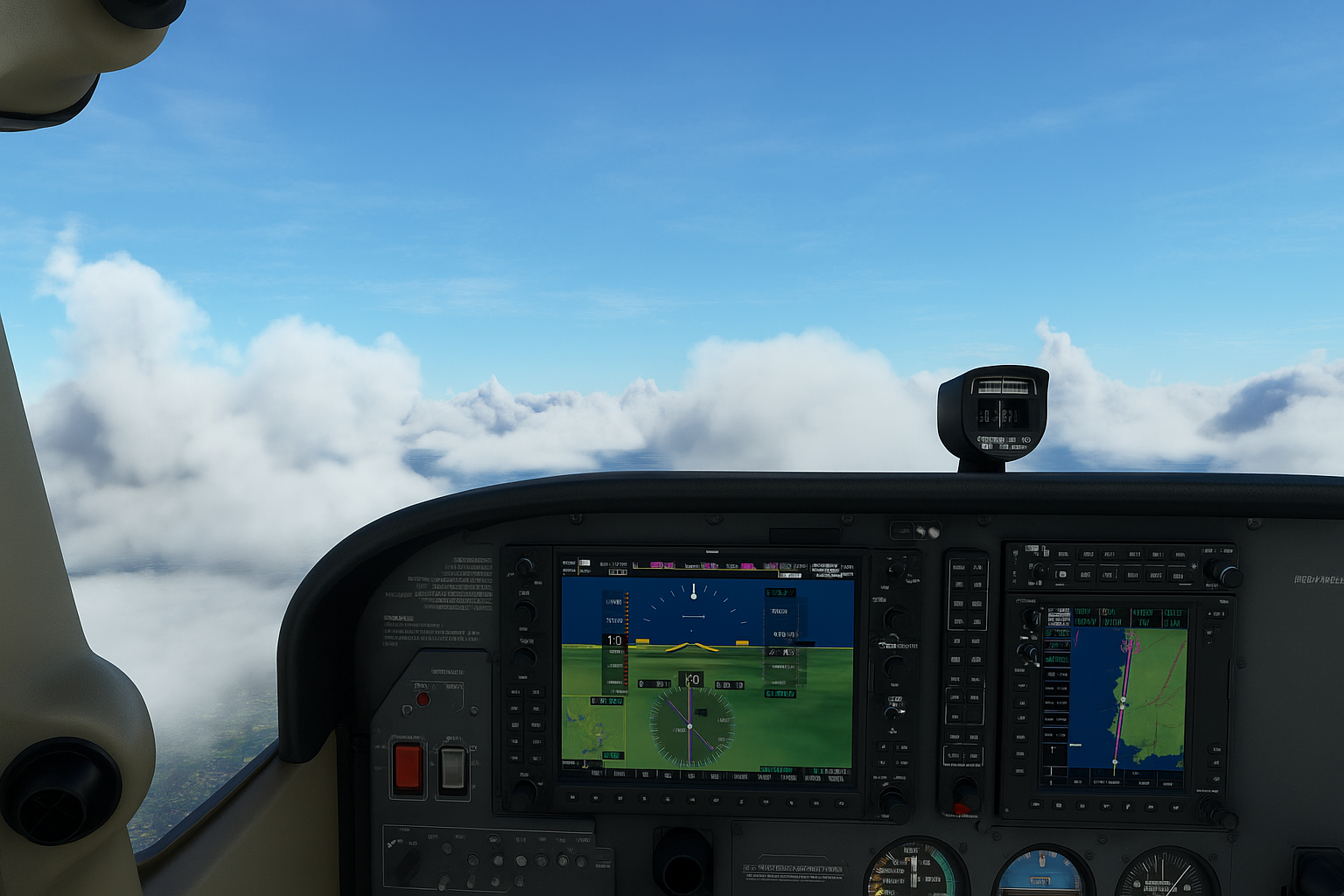Earning your Instrument Rating (IR) is one of the most transformative steps in your journey as a pilot. It expands your capabilities far beyond fair-weather flying, enabling you to operate in low visibility, navigate using only instruments, and fly more safely in a broader range of conditions. But instrument training can be challenging, time-consuming, and costly—especially without a strategic approach.
In this guide, we’ll explore proven strategies to make your instrument training more efficient, less expensive, and ultimately more rewarding.
1. Understand the Big Picture: What Instrument Training Involves
Before diving into tips, it’s crucial to understand the structure and requirements of instrument training.
FAA Requirements (Part 61):
- 50 hours cross-country PIC time (10 of these must be in airplanes if you’re seeking an airplane IR)
- 40 hours actual or simulated instrument time
- At least 15 hours with a CFII (Certified Flight Instructor – Instrument)
- Including a 250 NM cross-country under IFR
- Pass the FAA Knowledge Test
- Pass the Instrument Practical Test (checkride)
Knowing these requirements early lets you plan your training timeline, flying schedule, and study habits around the actual benchmarks you'll need to hit.
2. Build a Solid Foundation Before You Start
Many pilots jump into instrument training before they’ve fully mastered VFR fundamentals. This can make learning instrument procedures unnecessarily difficult.
Pre-Training Checklist:
- Perfect your basic attitude flying — smooth pitch, bank, and power changes.
- Be comfortable with your aircraft’s avionics — know your GPS, autopilot, and navigation radios inside out.
- Brush up on airspace, ATC communications, and charts — IFR adds complexity to all three.
Tip: If you can fly the aircraft precisely under VFR without looking outside for reference, you’re halfway to mastering IFR flying.
3. Choose the Right Training Path: Part 61 vs. Part 141

Your choice between a Part 61 and Part 141 flight school will affect your pace, cost, and structure.
- Part 61 – More flexibility in scheduling and pace; good for self-disciplined pilots or those training part-time.
- Part 141 – Structured syllabus, FAA-approved curriculum, reduced minimum hour requirements (35 vs. 40 instrument hours), ideal for full-time students.
If you’re trying to finish quickly, a 141 school with an accelerated program can save both time and money. If flexibility matters more, Part 61 may be your best option.
4. Master Ground Knowledge Before Stepping in the Cockpit
One of the most expensive mistakes students make is learning theory in the airplane at $200+ per hour.
Instead:
- Pass your FAA Instrument Knowledge Test early — use online courses like Sporty’s, King Schools, or Pilot Institute.
- Learn procedures on the ground — holds, approaches, missed approaches, and IFR enroute navigation can all be practiced at home.
- Use chair-flying — mentally rehearse flows and callouts with an approach plate in front of you.
Bottom Line: The more you know before your lesson, the less you’ll spend in the air.
5. Use a Flight Simulator to Supercharge Learning

Today’s home flight simulators (Microsoft Flight Simulator, X-Plane, or Redbird AATDs at your flight school) can mimic IFR conditions and procedures almost perfectly.
How to Use Simulators Effectively:
- Practice instrument scan techniques (e.g., the “T-scan” or “inverted-V scan”).
- Fly approach plates exactly as published — including missed approach procedures.
- Rehearse ATC phraseology to build speed and confidence in communications.
- Practice emergencies like vacuum pump failures or partial panel flying.
Tip: Even if your home sim isn’t FAA-approved for logging time, it’s still invaluable for muscle memory, mental flow, and avionics familiarity.
6. Schedule Training Frequently for Retention

Instrument flying is a perishable skill. Long gaps between lessons mean you’ll spend valuable lesson time relearning instead of progressing.
Optimal Training Schedule:
- 3+ lessons per week for accelerated progress.
- 2 lessons per week minimum to avoid skill erosion.
- If weather cancels a flight, replace it with a simulator or ground lesson.
Why It Matters: Instrument skills fade quickly—frequency is key to reducing total hours (and total cost).
7. Develop a Rock-Solid Instrument Scan
A consistent instrument scan is the backbone of IFR flying. You must constantly cross-check your instruments to detect even small deviations before they become big problems.
Scan Principles:
- Focus on the primary instrument for each phase of flight (e.g., attitude indicator for straight-and-level, altimeter for climbs).
- Cross-check supporting instruments without fixating.
- Avoid “chasing” the needles — make smooth, small corrections.
Pro Practice Tip: In a sim or with a safety pilot under the hood, fly for 10 minutes focusing solely on scan discipline.
8. Practice ATC Communication Early and Often
IFR clearances and communications are dense, fast, and full of abbreviations. Poor radio skills can overwhelm you in the cockpit.
Strategies:
- Listen to LiveATC.net daily — focus on IFR clearances at busy airports.
- Write down clearances using the CRAFT format (Clearance limit, Route, Altitude, Frequency, Transponder).
- Role-play with your instructor — practice readbacks until you’re concise and confident.
Clear, quick, and professional radio skills make IFR flying much smoother.
9. Integrate Real-World Weather from the Start
Instrument flying exists to handle challenging weather — so understanding real-world weather systems is critical.
Weather Mastery Tips:
- Study METARs, TAFs, AIRMETs, and SIGMETs until you can read them instantly.
- Use real weather during simulator sessions to match actual flying conditions.
- Review past weather cases and discuss with your instructor how you would have handled them.
Bonus: Knowing weather inside-out also helps with aeronautical decision-making (ADM) and passing your oral exam.
10. Learn to Think Ahead — Always Be Three Steps in Front of the Airplane
Instrument flying rewards proactive thinking. You should always know:
- Where you are now
- What’s next
- What comes after that
Examples:
- Before reaching a fix, have the next frequency, heading, and altitude ready.
- Before the final approach fix, be set up for landing configuration and ready for a missed approach.
This mindset prevents “getting behind the airplane” — one of the most common causes of IFR mistakes.
11. Embrace Partial Panel and Failure Scenarios
In real-world IFR, equipment can fail. You must be able to keep flying precisely with reduced information.
Partial Panel Practice:
- Fly approaches with a covered attitude indicator or heading indicator.
- Use GPS track and turn rate indicator as backups.
- Practice pitot-static and vacuum system failures in a simulator.
Your checkride will almost certainly include a partial panel approach — mastering it early builds both skill and confidence.
12. Debrief Every Lesson Thoroughly
Many students rush off after a lesson without fully understanding what went right or wrong. This wastes valuable learning opportunities.
Best Debrief Practices:
- Review each maneuver and procedure with your instructor.
- Identify one or two key improvement areas for the next lesson.
- Keep a training journal — log weather, lesson content, errors, and wins.
Over time, you’ll spot patterns and correct them faster.
13. Manage Costs Without Cutting Corners
Instrument training isn’t cheap, but smart planning can keep expenses in check.
Money-Saving Tips:
- Fly with safety pilots to log simulated instrument time at lower cost.
- Combine lessons — if you need cross-country PIC hours, plan them under simulated instrument conditions.
- Use a simulator for holds, intercepts, and approaches before practicing in the airplane.
The key is to maximize every dollar spent in the aircraft by coming prepared.
14. Prepare for the Checkride from Day One
Your checkride examiner will expect mastery of both knowledge and skills. If you integrate checkride prep into each lesson, you’ll avoid last-minute cramming.
Early Checkride Prep:
- Fly approaches exactly as you would on the checkride.
- Keep your logbook and IACRA application in order throughout training.
- Regularly review the Instrument Rating Airman Certification Standards (ACS) to track your progress.
By checkride week, everything will feel like just another training flight.
15. Stay Mentally Sharp and Physically Prepared
Instrument flying is mentally demanding. Fatigue, dehydration, and distraction make IFR mistakes more likely.
Pro Pilot Habits:
- Get adequate rest before every lesson.
- Stay hydrated and eat light — avoid heavy meals before flights.
- Use breathing techniques to stay calm under pressure.
A sharp mind and body can mean the difference between nailing a hold entry and blowing through it.
Final Thoughts
Instrument training is one of the most challenging — and rewarding — phases of your flight training journey. By approaching it with a clear plan, disciplined study habits, and efficient flying techniques, you’ll not only pass your checkride but also become a safer, more capable pilot.
Remember:
- Preparation saves money — learn procedures on the ground.
- Frequency builds skill — fly often to retain proficiency.
- Simulation accelerates progress — practice at home before the cockpit.
- Proactive thinking keeps you ahead — always be three steps in front of the airplane.
With the right strategies, your Instrument Rating can be earned efficiently, confidently, and with lasting skills you’ll use for a lifetime of flying.

Comments are closed.